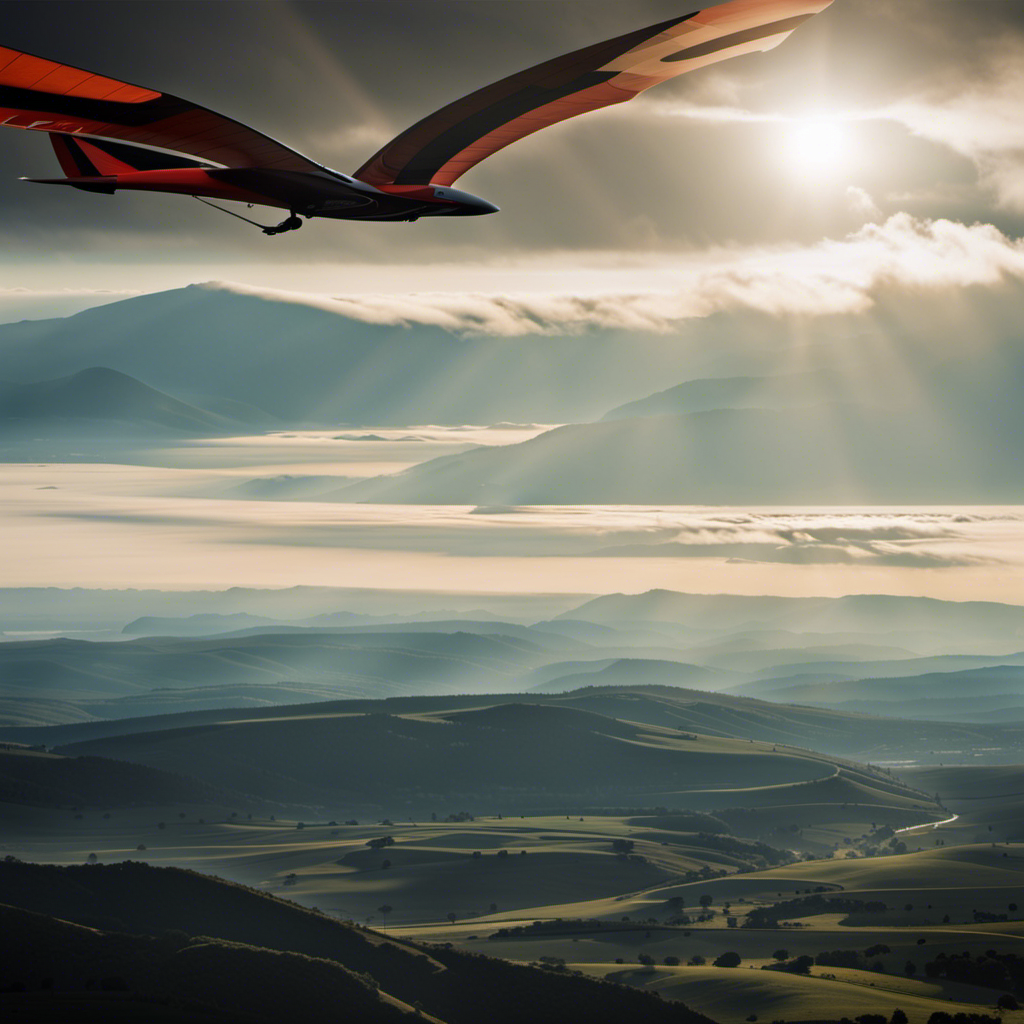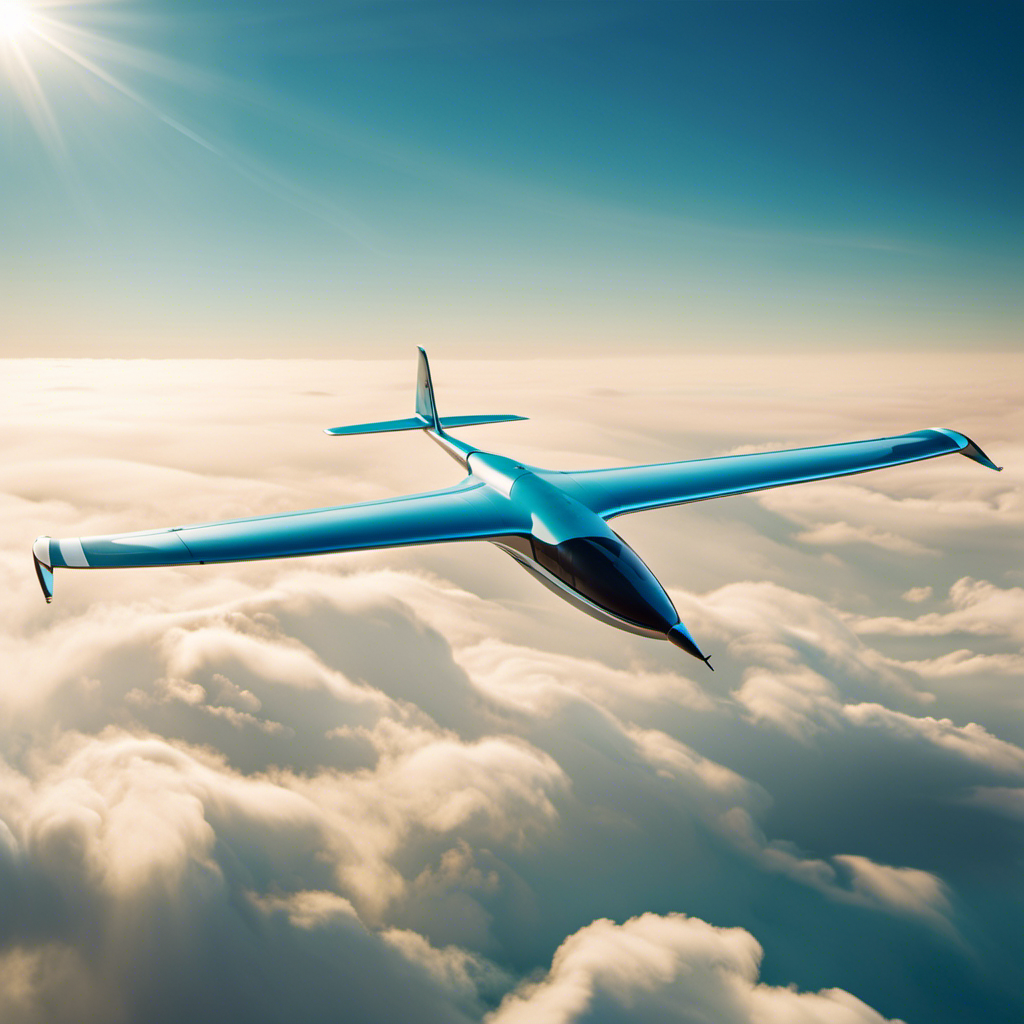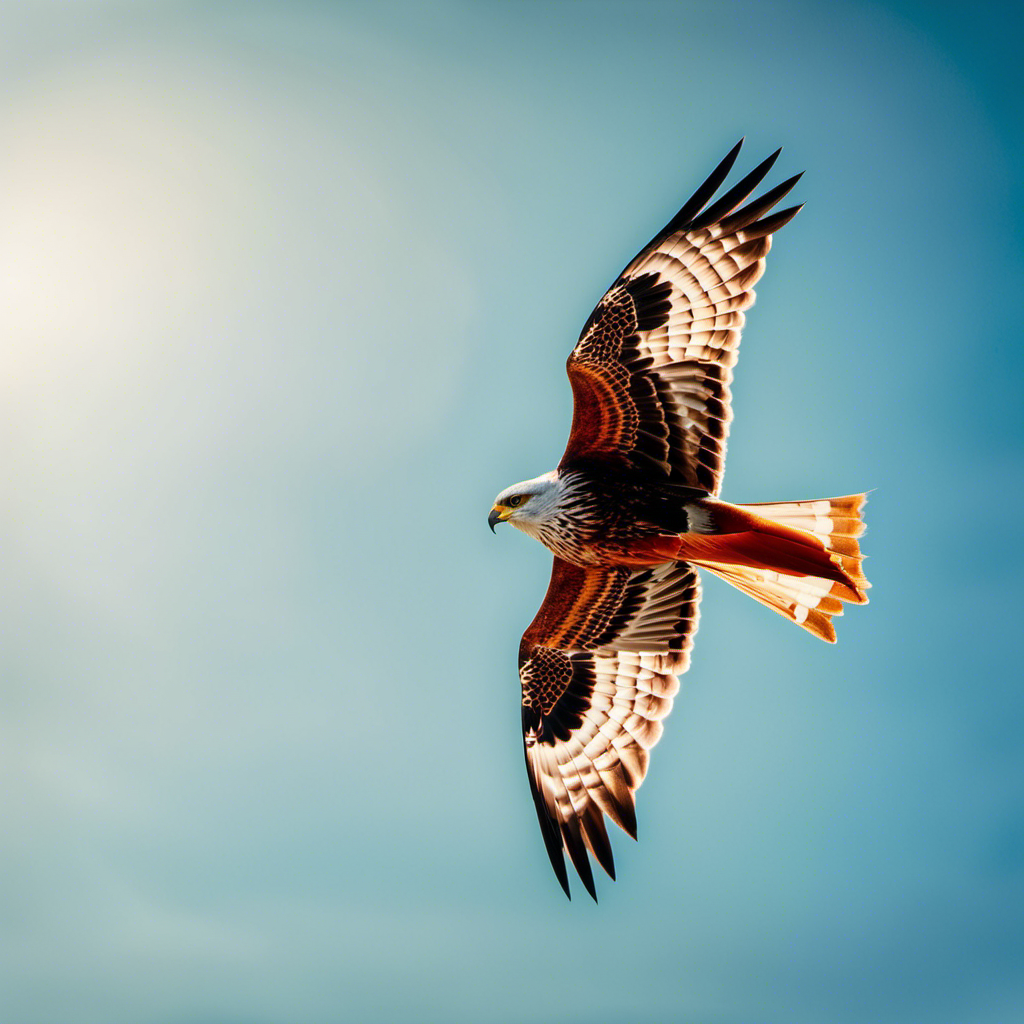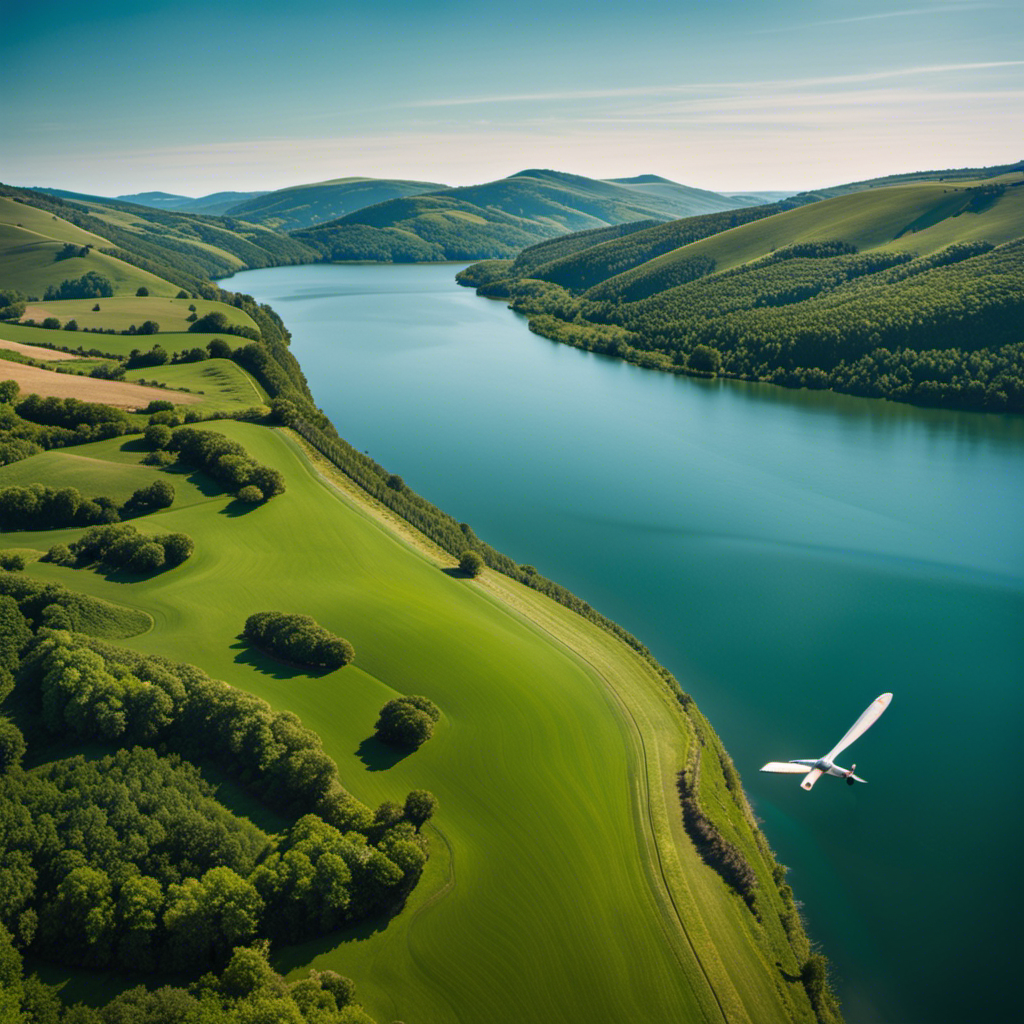Get ready to take your experience to the next level with the ultimate guide to Dynamic Soaring Gliders.
Brace yourself for an adrenaline-fueled adventure as we delve into the history, physics, and techniques behind this exhilarating sport.
Discover the perfect glider for your soaring aspirations and learn essential safety tips.
Uncover the best locations for dynamic soaring and find out how to capture breathtaking footage and photography.
Join me on this thrilling journey as we embrace the sheer beauty and excitement of dynamic soaring.
Let’s take flight!
Key Takeaways
- The recommended dynamic soaring locations are coastline, coastal cliff, mountain valley, desert dunes, and open field.
- Joining dynamic soaring communities and competitions can enhance the overall dynamic soaring experience and provide opportunities for learning and networking.
- Tips for capturing dynamic soaring footage and photography include using a high-quality camera with image stabilization, considering the use of a drone with a gimbal, practicing panning and tracking shots, and experimenting with camera settings.
- Participating in dynamic soaring events requires training in dynamic soaring techniques, maximizing the glider’s energy, and understanding the power of wind for a competitive edge.
History and Origins of Dynamic Soaring
The history and origins of dynamic soaring can be traced back to the early 20th century. Over time, dynamic soaring techniques have evolved, leading to significant advancements in glider design.
This technique involves exploiting the energy present in the wind gradient, which is the variation in wind speed at different altitudes. By flying in a specific pattern of ascending and descending arcs, gliders can harness the energy from this gradient and achieve remarkable speeds.
This evolution in dynamic soaring techniques has revolutionized glider design, as engineers now focus on creating aircraft that are optimized for this type of flight.
Understanding the Physics Behind Dynamic Soaring
In understanding the physics behind dynamic soaring, it’s crucial to examine the role of wind shear and how it affects the flight of gliders.
Wind shear refers to the change in wind speed and direction with increasing altitude. This variation in wind velocity can be utilized by gliders to extract energy from the wind gradient, allowing them to gain altitude and maintain their flight.
The Role of Wind Shear
Understanding wind shear is crucial for maximizing the performance of your dynamic soaring glider.
Wind shear refers to the change in wind patterns with altitude, and it can have a significant impact on flight performance.
As a pilot, it is important to recognize and utilize these changes to your advantage.
When flying a dynamic soaring glider, wind shear can provide an opportunity to gain or lose energy.
By flying into a headwind, you can gain speed and height, and then utilize the energy from the wind gradient to maintain or increase your speed.
This technique allows you to efficiently extract energy from the wind and achieve longer flights.
Utilizing Energy from the Wind Gradient
Utilizing energy from the wind gradient can greatly enhance the performance of your glider. Wind gradient techniques involve taking advantage of the varying wind speeds at different altitudes. By understanding these variations, you can optimize your flight patterns and maximize the energy available for dynamic soaring.
When flying in the lower layers of the atmosphere, where the wind speed is typically lower, you can use techniques such as ridge soaring or slope soaring to gain lift. As you ascend to higher altitudes, where the wind speed increases, you can employ techniques like thermal soaring or wave soaring to harness the additional energy.
These wind gradient techniques allow you to maintain continuous flight and cover long distances. By effectively utilizing the energy from the wind gradient, you can achieve longer and more efficient flights.
Now, let’s delve into the next section on choosing the right glider for dynamic soaring.
Choosing the Right Glider for Dynamic Soaring
When choosing the right glider for dynamic soaring, it’s important to consider factors such as wing design and weight distribution. The right equipment is crucial in harnessing the full potential of dynamic soaring.
The glider’s wing design plays a significant role in its performance. Opting for wings with a low aspect ratio allows for better maneuverability and control in high wind conditions.
Additionally, the weight distribution of the glider affects its stability during flight. A well-balanced glider ensures smooth transitions between the wind gradients, maximizing energy extraction.
Understanding flying conditions is equally important. Analyzing wind patterns, wind strength, and direction provides valuable insights into choosing the appropriate glider for different flying conditions.
By carefully considering these factors, one can select a glider that optimizes their dynamic soaring experience.
Transitioning into the next section, learning the techniques of dynamic soaring requires a deep understanding of aerodynamics and precise control of the glider’s movements.
Learning the Techniques of Dynamic Soaring
Now that you’ve chosen the perfect glider for dynamic soaring, it’s time to delve into the exciting world of mastering the wind. Learning the techniques of dynamic soaring is crucial for maximizing the performance of your glider and achieving those breathtaking speeds.
By harnessing the power of the wind, you can execute precise maneuvers and experience the thrill of gliding effortlessly through the air.
To help you visualize the process, imagine the following scenarios:
-
Picture your glider soaring high above the cliffs, gracefully riding the updrafts that form as the wind hits the terrain.
-
Envision your glider banking sharply, using the wind’s energy to gain altitude and execute a tight turn.
-
Imagine your glider skimming just above the surface of the water, utilizing the wind gradient to maintain speed and stability.
By understanding and applying these dynamic soaring techniques, you can unlock the true potential of your glider and soar to new heights.
Now, let’s move on to the next section, where we’ll discuss safety tips for dynamic soaring.
Safety Tips for Dynamic Soaring
Before diving into the exhilarating world of dynamic soaring, it’s important to familiarize yourself with essential safety tips to ensure a smooth and secure flight experience. Safety precautions are crucial to minimize risks and maximize enjoyment.
Firstly, always inspect your equipment thoroughly before each flight. Check for any damage or wear and tear that may compromise your safety.
Secondly, make sure you have the necessary equipment requirements, such as a reliable radio transmitter and receiver, a high-quality glider with strong wings, and proper safety gear like a helmet and goggles.
Additionally, it is vital to fly in suitable weather conditions, avoiding strong winds or turbulent weather.
By following these safety precautions, you can embark on your dynamic soaring adventures with confidence.
Now, let’s delve into the realm of advanced dynamic soaring techniques and tricks.
Advanced Dynamic Soaring Techniques and Tricks
To take your flying skills to the next level, try incorporating advanced techniques and tricks into your dynamic soaring routine. These techniques are designed to optimize your glider’s performance and push the limits of what it can do.
One technique is called ‘wave hopping,’ where you ride the updrafts created by waves in the atmosphere. This allows you to gain altitude and maintain speed for longer periods of time.
Another technique is ‘speed bar pumping,’ where you use the speed bar to quickly pump the glider’s wings and generate extra lift. This can be particularly useful when trying to gain height in turbulent conditions.
By mastering these advanced dynamic soaring techniques, you’ll be able to achieve greater heights and longer flight times.
Now let’s explore some recommended dynamic soaring locations where you can put these techniques into practice.
Recommended Dynamic Soaring Locations
One popular location for dynamic soaring is the coastline, where the combination of wind and waves creates ideal conditions for long flights. When searching for the best wind conditions, it’s important to consider factors such as wind speed, direction, and stability. To ensure a successful dynamic soaring experience, proper preparation is key. This includes checking weather forecasts, assessing the terrain, and selecting the appropriate glider for the conditions. Below is a table listing some recommended dynamic soaring locations and their corresponding wind conditions:
| Location | Wind Speed (mph) | Wind Direction | Wind Stability |
|---|---|---|---|
| Coastal Cliff | 20-30 | Onshore | Stable |
| Mountain Valley | 15-25 | Downwind | Unstable |
| Desert Dunes | 10-20 | Crosswind | Variable |
| Open Field | 5-15 | Any | Calm |
Joining Dynamic Soaring Communities and Competitions
When it comes to participating in dynamic soaring events, online forums and discussion groups play a vital role. These platforms serve as a hub for discussions on techniques, equipment, and upcoming events. They allow participants to stay updated and engaged. By actively participating in these online communities, individuals can expand their knowledge, network with other like-minded individuals, and enhance their overall dynamic soaring experience.
Online Forums and Discussion Groups
You can find valuable information and connect with other enthusiasts on online forums and discussion groups. Here are some reasons why these platforms are essential for dynamic soaring glider enthusiasts:
-
Access to online tutorials: Online forums and discussion groups provide a wealth of knowledge through tutorials. From basic glider assembly to advanced flying techniques, you can learn at your own pace.
-
Troubleshooting techniques: When you encounter issues with your glider, these communities offer troubleshooting advice. Experts and experienced enthusiasts share their insights, helping you resolve problems efficiently.
By actively participating in these forums, you can enhance your understanding of dynamic soaring gliders and improve your flying skills.
Now, let’s delve into the exciting world of participating in dynamic soaring events, where you can put your knowledge and skills to the test.
Participating in Dynamic Soaring Events
After gathering valuable insights from online forums and discussion groups, I am now ready to take my passion for dynamic soaring to the next level by participating in dynamic soaring competitions. These events provide an incredible opportunity to showcase my skills and compete against other experienced pilots.
To prepare for these competitions, I have been diligently training in dynamic soaring techniques, honing my ability to navigate the wind patterns and maximize the energy of the glider. By understanding how to effectively use the power of the wind, I can achieve greater speeds and longer flight durations, giving me a competitive edge during these events.
Now, let’s transition to the next section where we will explore some valuable tips for capturing dynamic soaring footage and photography.
Tips for Capturing Dynamic Soaring Footage and Photography
If you’re interested in capturing dynamic soaring footage and photography, here are some helpful tips.
-
Choose the Right Equipment:
Invest in a high-quality camera with excellent image stabilization capabilities for clear and steady shots.
Consider using a drone with a gimbal to get aerial footage from different angles. -
Master the Techniques:
Learn how to track fast-moving objects by practicing panning and tracking shots.
Experiment with different camera settings, such as shutter speed and aperture, to capture the essence of speed and motion.
To truly embrace the thrill and beauty of dynamic soaring, one must understand the art of capturing it through the lens. By employing the right equipment and mastering the techniques, you can immortalize the incredible speed and agility of dynamic soaring gliders.
Embracing the Thrill and Beauty of Dynamic Soaring
To capture the thrill and beauty of dynamic soaring, embrace the art of immortalizing it through your lens. Exploring dynamic soaring techniques for capturing aerial footage is a challenging yet rewarding endeavor. It requires a deep understanding of the dynamics of soaring through the wind and the ability to adapt to ever-changing conditions.
The art of dynamic soaring lies in capturing the sheer elegance and grace of these gliders as they effortlessly navigate the sky. It’s about conveying the sense of freedom and exhilaration that comes with soaring at high speeds. To achieve this, one must master the art of composition, lighting, and timing. Each shot must tell a story, evoking the emotions experienced during dynamic soaring.
Frequently Asked Questions
What are the benefits of dynamic soaring compared to other forms of gliding?
The advantages of dynamic soaring compared to other forms of gliding include increased speed and efficiency. By utilizing specific techniques such as exploiting wind gradients, dynamic soaring allows for longer and faster flights.
How long does it typically take to become proficient in dynamic soaring?
It typically takes several months of consistent training to become proficient in dynamic soaring. Mastering dynamic soaring techniques requires a thorough understanding of wind patterns, precise control of the glider, and extensive practice in different weather conditions.
Are there any restrictions or regulations for flying a dynamic soaring glider?
There are restrictions and regulations for flying a dynamic soaring glider. It is important to comply with airspace regulations, obtain the necessary permits, and follow safety guidelines to ensure a safe and legal flight.
Can you explain the differences between dynamic soaring and slope soaring?
Dynamic soaring is like riding a roller coaster with a bird. It involves using wind gradients and air currents to gain energy and speed. In contrast, slope soaring relies solely on the wind hitting a slope to generate lift.
How can weather conditions affect the success of dynamic soaring flights?
Weather conditions, such as wind patterns, play a crucial role in the success of dynamic soaring flights. Understanding and leveraging favorable weather conditions can help maximize flight performance and achieve longer flight durations.
Conclusion
In conclusion, dynamic soaring is a fascinating and exhilarating sport that combines the thrill of flying with the beauty of nature.
With its origins rooted in the early days of aviation, dynamic soaring has evolved into a complex and precise technique that requires a deep understanding of physics and a skilled pilot.
By choosing the right glider, learning the techniques, and practicing in recommended locations, you can fully embrace the thrill of dynamic soaring.
So, spread your wings and soar like a bird, effortlessly riding the wind currents to new heights.
With a heart that soars as high as the skies, Aria, affectionately known as “Skylark,” is the driving force behind Soaring Skyways. Her journey into the gliding world began as a young dreamer gazing up at the soaring birds, yearning to experience the weightlessness and freedom they embodied. With years of experience both in the cockpit and behind the scenes, Aria’s commitment to the gliding community is unwavering.










